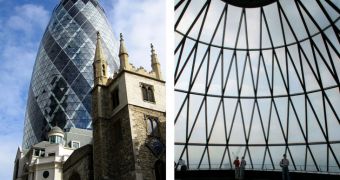A technology originally developed for use in outer space is currently being used to create new energy-saving windows and insulating glass. This is possible through the use of a new sensors, which space agencies use to measure the number of oxygen atoms in the proximity of space vehicles.
But experts had the idea of translating this technology here on Earth as well, especially given the large number of glass facades that exist throughout the world's most developed and populous cities.
The large number of such edifices means that, if the technology used to create their windows are inefficient, then massive amounts of energy are lost. By refining the way glass is constructed, scientists could literally reduce costs significantly, and contribute to reducing pollution.
Glass features numerous characteristics, but one of the most important is insulation. The material can keep a room cool during summer days, and heated during the winter. “By using sensor technology from space this has been possible,” says Frank Hammer.
He is one of the founding members of the German company ESCUBE, which was in charge of developing the special sensor. The technology was given to a glass manufacturer for testing, via MST Aerospace. The latter is the German technology broker for the ESA Technology Transfer Program.
“For space, the sensor was developed to measure atomic oxygen, known for its erosion effect and for degrading optical surfaces. In the glass industry the technology is now used to control the industrial glass-coating process to obtain improved insulating properties,” Hammer explains.
“The gas sensor developed to handle the harsh space environment turned out to be the right solution to handle the difficult glass-production conditions of high temperatures and reactive gases,” he adds.
What experts are looking to obtain by using the new sensor is develop new coating materials for glass, and also to improve on existing coating technologies. Results obtained using the sensor thus far have been encouraging, and the collaboration plans to press ahead with its efforts.
“With ESCUBE’s sensor it is today possible to offer new types of glass. Their surfaces not only take into account economic and ecological criteria but also fulfill aesthetic criteria, saving energy by the low overall heat transfer coefficients,” says Peter Hennes, from the glass company iSATT.
“With the new coating the overall heat transfer coefficients have been reduced to about a third of what they were in the 1980s, while maintaining light transmittance at 80 [percent],” he goes on to say.
“The light passing through is almost the same as standard glass, but the heat loss during winter and the hat gain during summer have been reduced significantly,” Hennes concludes.

 14 DAY TRIAL //
14 DAY TRIAL //